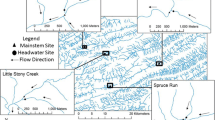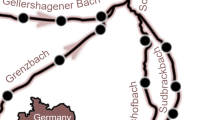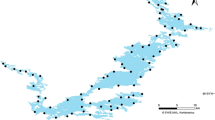Abstract
Habitat connectivity and regional heterogeneity represent two factors likely to affect biodiversity across different spatial scales. We performed a 3 × 2 factorial design experiment to investigate the effects of connectivity, heterogeneity, and their interaction on artificial pond communities of freshwater invertebrates at the local (α), among-community (β), and regional (γ) scales. Despite expectations that the effects of connectivity would depend on levels of regional heterogeneity, no significant interactions were found for any diversity index investigated at any spatial scale. While observed responses of biodiversity to connectivity and heterogeneity depended to some extent on the diversity index and spatial partitioning formula used, the general pattern shows that these factors largely act at the β scale, as opposed to the α or γ scales. We conclude that the major role of connectivity in aquatic invertebrate communities is to act as a homogenizing force with relatively little effect on diversity at the α or γ levels. Conversely, heterogeneity acts as a force maintaining differences between communities.


Similar content being viewed by others
References
Barnett A, Beisner B (2007) Zooplankton biodiversity and lake trophic state: explanations invoking resource abundance and distribution. Ecology 88:1675–1686
Barnett AJ, Finlay K, Beisner BE (2007) Functional diversity of crustacean zooplankton communities: towards a trait based classification. Freshw Biol 52:796–813
Cáceres CE, Tessier AJ (2004) To sink or swim: variable diapause strategies among Daphnia species. Limnol Oceanogr 49:1333–1340
Cadotte MW (2006a) Dispersal and species diversity: a meta-analysis. Am Nat 167:913–924
Cadotte MW (2006b) Metacommunity influences on community richness at multiple spatial scales: a microcosm experiment. Ecology 87:1008–1016
Cadotte MW, Fukami T (2005) Dispersal, spatial scale, and species diversity in a hierarchically structured experimental landscape. Ecol Lett 8:548–557
Cadotte MW, Fortner AM, Fukami T (2006) The effects of resource enrichment, dispersal, and predation on local and metacommunity structure. Oecologia 149:150–157
Chesson P (2000) Mechanisms of maintenance of species diversity. Annu Rev Ecol Syst 31:343–366
Clark JS, Dietze M, Chakraborty S, Agarwal PK, Ibanez I, LaDeau S, Wolosin M (2007) Resolving the biodiversity paradox. Ecol Lett 10:647–662
Davies KF, Holyoak M, Preston KA, Offeman VA, Lum Q (2009) Factors controlling community structure in heterogeneous metacommunities. J Anim Ecol 78:937–944
Declerck S, Vanderstukken M, Pals A, Muylaert K, De Meester L (2007) Plankton biodiversity along a gradient of productivity and its mediation by macrophytes. Ecology 88:2199–2210
Derry AM, Arnott SE (2007) Zooplankton community response to experimental acidification in boreal shield lakes with different ecological histories. Can J Fish Aquat Sci 64:887–898
Forbes AE, Chase JM (2002) The role of habitat connectivity and landscape geometry in experimental zooplankton metacommunities. Oikos 96:433–440
Gilbert F, Gonzalez A, Evans-Freke I (1998) Corridors maintain species richness in the fragmented landscapes of a microecosystem. Proc R Soc Lond B 265:577–582
Gotelli NJ, Colwell RK (2001) Quantifying biodiversity: procedures and pitfalls in the measurement and comparison of species richness. Ecol Lett 4:379–391
Hastings A (1980) Disturbance, coexistence, history, and competition for space. Theor Pop Biol 18:363–373
Hutchinson GE (1961) The paradox of the plankton. Am Nat 95:137–145
Jost L (2006) Entropy and diversity. Oikos 113:363–375
Jost L (2007) Partitioning diversity into independent alpha and beta components. Ecology 88:2427–2439
Kneitel JM, Miller TE (2003) Dispersal rates affect species composition in metacommunities of Sarracenia purpurea inquilines. Am Nat 162:165–171
Lande R (1996) Statistics and partitioning of species diversity, and similarity among multiple communities. Oikos 76:5–13
Leibold MA, Holyoak M, Mouquet N, Amarasekare P, Chase JM, Hoopes MF, Holt RD, Shurin JB, Law R, Tilman D, Loreau M, Gonzalez A (2004) The metacommunity concept: a framework for multi-scale community ecology. Ecol Lett 7:601–613
Loreau M, Naeem S, Inchausti P, Bengtsson J, Grime JP, Hector A, Hooper DU, Huston MA, Raffaelli D, Schmid B, Tilman D, Wardle DA (2001) Biodiversity and ecosystem functioning: current knowledge and future challenges. Science 294:804–808
Mouquet N, Loreau M (2003) Community patterns in source-sink metacommunities. Am Nat 162:544–557
Mouquet N, Hoopes MF, Amarasekare P (2005) The world is patchy and heterogeneous! Trade-off and source-sink dynamics in competitive metacommunities. In: Holyoak M, Leibold MA, Holt RD (eds) Metacommunities: spatial dynamics and ecological communities. University of Chicago Press, Chicago, pp 237–262
Petchey OL, Gaston KJ (2002) Functional diversity (FD), species richness, and community composition. Ecol Lett 5:402–411
Pimm SL, Russell GJ, Gittleman JL, Brooks TM (1995) The future of biodiversity. Science 269:347–350
R Development Core Team (2008) R: a language and environment for statistical computing. R Foundation for Statistical Computing, Vienna
Ricotta C (2005) A note on functional diversity measures. Basic Appl Ecol 6:479–486
Ricotta C (2010) On beta diversity decomposition: trouble shared is not trouble halved. Ecology 91:1981–1983
Shurin JB (2000) Dispersal limitation, invasion resistance, and the structure of pond zooplankton communities. Ecology 81:3074–3086
Simpson EH (1949) Measurement of diversity. Nature 163:688
Strecker AL, Arnott SE (2010) Complex interactions between regional dispersal of native taxa and invasive species. Ecology 91:1035–1047
Thomas JA, Telfer MG, Roy DB, Preston CD, Greenwood JJD, Asher J, Fox R, Clarke RT, Lawton JH (2004) Comparative losses of British butterflies, birds, and plants and the global extinction crisis. Science 303:1879–1881
Tilman D, Knops J, Wedin D, Reich P, Ritchie M, Siemann E (1997) The influence of functional diversity and composition on ecosystem processes. Science 277:1300–1302
Warren PH (1996a) The effects of between habitat dispersal rate on protist communities and metacommunities in microcosms at two spatial scales. Oecologia 105:132–140
Warren PH (1996b) Dispersal and destruction in a multiple habitat system: an experimental approach using protist communities. Oikos 77:317–325
Wetzel RG (2001) Limnology. Academic Press, San Diego
Whittaker RH (1972) Evolution and measurement of species diversity. Taxon 21:213–251
Worm B, Barbier EB, Beaumont N, Duffy JE, Folke C, Halpern BS, Jackson JBC, Lotze HK, Micheli F, Palumbi SR, Sala E, Selkoe KA, Stachowicz JJ, Watson R (2006) Impacts of biodiversity loss on ocean ecosystem services. Science 314:787–790
Zar JH (1999) Biostatistical analysis. Prentice Hall. Upper Saddle River
Acknowledgments
This research was supported by an Natural Sciences and Engineering Research Council of Canada (NSERC) Discovery Grant to SEA, and MTP was supported by an NSERC CGS-M award and PGS-M extension. Logistical support was provided by the Queen’s University Biological Station. Invaluable field assistance for this project was provided by Janine Lee, Steve Hawrylyshyn, Frank Phelan, Floyd Conor, Niki Willie, Megan MacLennan, Alexandra Howard, Catherine Gieystzor, Angela Strecker, Justin Shead, Hannah Kent, Colin MacLeod, Becky Torrance, and Wes Pedruski. The manuscript was greatly improved by helpful comments from Angela Strecker, Stephen Declerk, Zoë Lindo, Jonathan Shurin, three anonymous reviewers, and Jonathan Whiteley.
Author information
Authors and Affiliations
Corresponding author
Additional information
Communicated by Jonathan Shurin.
Electronic supplementary material
Below is the link to the electronic supplementary material.
Rights and permissions
About this article
Cite this article
Pedruski, M.T., Arnott, S.E. The effects of habitat connectivity and regional heterogeneity on artificial pond metacommunities. Oecologia 166, 221–228 (2011). https://doi.org/10.1007/s00442-010-1814-y
Received:
Accepted:
Published:
Issue Date:
DOI: https://doi.org/10.1007/s00442-010-1814-y




